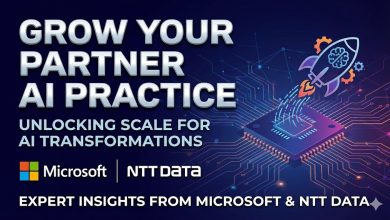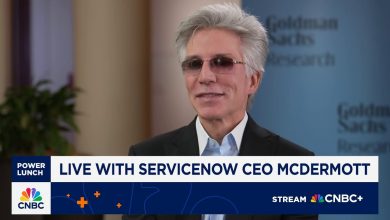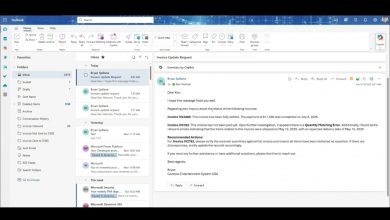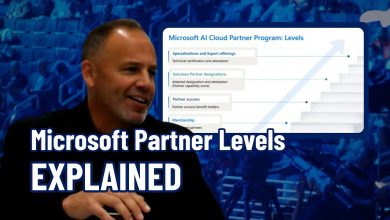Blockchain Ecosystem – Blueprint for Partner Collaboration Model
Blockchain ecosystems are typically decentralized, meaning that no single entity has control over the entire network.
 A blockchain ecosystem is a decentralized network that enables secure and transparent transactions.
A blockchain ecosystem is a decentralized network that enables secure and transparent transactions.
It consists of various components that work together to ensure the integrity and efficiency of the system. In this article, we will explore the different parts of a blockchain ecosystem and their roles.
A blockchain ecosystem is built on the foundation of blockchain technology, which is a distributed ledger that records and verifies transactions across multiple computers. It eliminates the need for intermediaries and provides a secure and transparent way of conducting transactions.
Blockchain ecosystems are typically decentralized, meaning that no single entity has control over the entire network. Instead, the network is maintained by a community of participants, known as nodes, who validate and verify transactions.
In the featured video Tim O’Brien, Director, Ecosystem Growth, Constellation Network gave an overview of the Constellation Network, the blockchain network evolution, elements of the ecosystem and development of the ecosystem, node setup and build requirements and outcomes.
Component Parts
- Blockchain Protocol – The blockchain protocol is the underlying technology that enables the creation and maintenance of the blockchain. It defines the rules and consensus mechanisms that govern the network. Examples of blockchain protocols include Bitcoin, Ethereum, and Hyperledger.
- Nodes – Nodes are the individual computers or devices that participate in the blockchain network. They store a copy of the blockchain and validate transactions. There are different types of nodes, including full nodes, which store the entire blockchain, and lightweight nodes, which only store a subset of the blockchain.
- Smart Contracts – Smart contracts are self-executing contracts with the terms of the agreement directly written into code. They automatically execute transactions when predefined conditions are met. Smart contracts enable automation and eliminate the need for intermediaries in various industries, such as finance, supply chain, and real estate.
- Cryptocurrency – Cryptocurrency is a digital or virtual currency that uses cryptography for security. It is often used as a medium of exchange within blockchain ecosystems. Examples of cryptocurrencies include Bitcoin, Ethereum, and Ripple.
- Consensus Mechanisms – Consensus mechanisms are algorithms or protocols that ensure agreement among the nodes in the network. They determine how transactions are validated and added to the blockchain. Examples of consensus mechanisms include Proof of Work (PoW) and Proof of Stake (PoS).
- Wallets – Wallets are digital tools that allow users to store, manage, and transact cryptocurrencies. They provide a secure way to hold private keys, which are required to access and transfer funds. Wallets can be software-based, hardware-based, or even paper-based.
- DApps (Decentralized Applications) – DApps are applications that run on a blockchain network. They leverage the decentralized nature of the blockchain to provide secure and transparent services. DApps can be built on various blockchain platforms and offer a wide range of functionalities, such as decentralized finance, gaming, and identity management.
Conclusion
A blockchain ecosystem is a complex network of interconnected components that work together to enable secure and transparent transactions.
The blockchain protocol, nodes, smart contracts, cryptocurrency, consensus mechanisms, wallets, and DApps are all integral parts of a blockchain ecosystem. Understanding these components is crucial for anyone looking to explore the potential of blockchain technology.
Virtual Enterprise Organizations and Entrepreneur Ecosystems
A headline example is ‘Virtual Business Ecosystems’, a digital marketplace akin to Uber or Airbnb but for a general mix of businesses seeking to expand their collective capabilities through group partnership collaboration.
This is based on a central principle of ‘micro-enterprise’ (ME) organizations forming themselves into a larger whole, a Virtual Enterprise (VE), achieved through technology. It’s been a popular concept in Europe for some years, pioneered by initiatives such as the ALIVE project for example, which produced this report describing the legal templates for constituting such an ecosystem.
How to design these business systems is effectively articulated through this article by Simone Cicero, an expert in Platform Ecosystems. Citing his work with Professor Bill Fischer of the Haier Group, Simone describes a model for building an ‘Entrepreneurial, Ecosystem Enabling Organization‘
These VE networks can be achieved through members each playing a distinct role – Simone describes ‘User MEs’ and ‘Node MEs’, and ALIVE ‘Order Brokers’, ‘Order Managers’, ‘In- and Outsourcing Manager’, ‘Network Coach’ and ‘Auditor’. Common building blocks are established such as Shared Services for functions like HR, IT and Finance.
Haier created a blockchain based, smart contract application, that all the stakeholders in the ecosystem can use to participate (by bidding for contracts), enabling a distributed, self-organizing system vs a centralized model.
Obviously many networking community models already exist, but these are mostly informal and ad-hoc. At the other end of spectrum are government programs, entirely formal and with that also very specific and fixed in their purpose.
The goal of these entrepreneurial ecosystems lies in between the two, providing some degree of organized structure but through loosely coupled and dynamic collaborations, the blend of the fluid adaptability of informal networking with the structures of formal programs and resources, that can be directed towards key outcomes:
- Foster collaborations that create new market innovations and leverage assets in new ways.
- Enable micro-enterprises to co-bid RFP opportunities that they are too small to pursue directly.
- Support entrepreneurs through an ‘Idea to Venture’ startup life-cycle.
Alastria – A Blockchain Ecosystem Platform
As Simon describes the enabling platform that Haier created is a blockchain based, smart contract application, and in conjunction with SSI these are the key technologies for enabling these types of virtual collaboration ecosystems.
An example of this approach is the Spanish Alastria project, a model achieved through a consortium of small and large organizations and some government agencies, who collaborate to define and implement a shared, common Blockchain infrastructure, built atop Self Sovereign Identity.
The critical factor is that the platform enables the development of an ecosystem of participants. In this video presentation, with supporting slides, they explain how this non-profit organization and multi-organization member forum acts together to form a “National Blockchain Network”.
As the diagram shows the key dynamic is that members collaborate to build the common platform standards and technologies, and compete in terms of building application services on it. It would act as an accelerator of new Blockchain innovations and thus drive a massive economic growth.
From 7:00m it is explained how the ecosystem this makes possible, with different market entities fulfilling roles such as User, Service Provider and Attester, a system for securely sharing identity credentials to underpin integrated digital services.
The most dramatic leap towards the future of work will be accelerated by an underlying paradigm shift: Transforming the very nature of organizations.
A decentralized autonomous organization (DAO) is an innovative concept that has emerged with the advent of blockchain technology.
DAOs have the potential to revolutionize the way organizations are structured and operated, offering numerous benefits and opportunities for the future.
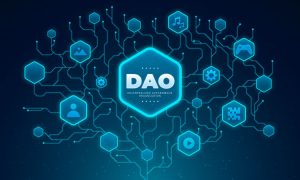 What is a DAO?
What is a DAO?
What is a DAO? Simply put, DAOs or Decentralized Autonomous Organizations are community entities with distributed decision-making processes.
A DAO is a digital entity that operates through smart contracts on a blockchain, governed by a set of predefined rules and protocols that are encoded into the blockchain, ensuring transparency and immutability.
Think of it like a digital community with a common bank account. DAOs have been created to buy NFTs, fast food restaurants, rare cultural artifacts and even an original copy of the US constitution.
However, DAOs are more than just curious blockchain projects – their innovative utilization of smart contracts and governance protocols may represent a bold new future for more business processes and even the operating models for more traditional organizations, charities or political action groups.
DAOs aim to eliminate the need for traditional hierarchical structures and centralized decision-making processes by allowing stakeholders to participate directly in the decision-making and governance of the organization.
Key Features of DAOs
DAOs possess several key features that differentiate them from traditional organizations, offering the potential to transform the future of organizations in several ways:
- Decentralized Governance: DAOs operate on a decentralized governance model, where decisions are made collectively by stakeholders rather than a central authority. By eliminating the need for centralized decision-making, DAOs enable more democratic and inclusive decision-making processes. Every participant has a voice and can contribute to the decision-making process, leading to more fair and representative outcomes.
- Transparency: All transactions and decisions within a DAO are recorded on the blockchain, providing full transparency to all participants. The transparent nature of blockchain technology ensures that all transactions and decisions within a DAO are visible to all participants. This transparency builds trust among stakeholders and reduces the risk of fraud or corruption.
- Autonomy: DAOs are designed to be autonomous and self-executing, with predefined rules and protocols that govern their operations.
- Tokenized Ownership: DAOs often utilize tokens to represent ownership and participation rights within the organization.
- Community-driven Global Collaboration: DAOs encourage active participation from their community members, fostering a sense of ownership and collaboration. DAOs are not bound by geographical limitations, allowing individuals from different parts of the world to collaborate and contribute to the organization. This opens up new opportunities for global talent and expertise.
- Efficiency and Cost Reduction: DAOs automate many operational processes through smart contracts, reducing the need for intermediaries and administrative overhead. This leads to increased efficiency and cost savings for organizations.
This tokenization model aligns the interests of participants with the success of the organization, fostering a more engaged and motivated community.
AI + Blockchain = Future of Work
The NEAR Protocol Youtube video titled “Layer 1 Stage | AI + Blockchain = Future of Work” explores the exciting intersection of artificial intelligence (AI) and blockchain technology in shaping the future of work.
It emphasizes the need for scalable and efficient solutions to support the integration of AI and blockchain.
- AI and Blockchain – The video explains how AI and blockchain can complement each other. AI can enhance blockchain technology by improving data analysis, pattern recognition, and decision-making processes. On the other hand, blockchain can provide a secure and transparent infrastructure for AI models and data sharing.
- Future of Work – The NEAR Protocol team discusses the impact of AI and blockchain on the future of work. They highlight the potential for decentralized autonomous organizations (DAOs) that leverage AI and blockchain to create trustless and efficient systems. These systems can streamline processes, eliminate intermediaries, and enable new forms of collaboration and value creation.
Conclusion and Vendor List
Decentralized autonomous organizations (DAOs) represent a paradigm shift in the way organizations are structured and operated. With their decentralized governance, transparency, and potential for global collaboration, DAOs offer a transformative vision for the future of organizations.
While challenges and considerations exist, the benefits and opportunities presented by DAOs make them an exciting prospect for organizations looking to embrace innovation and harness the power of blockchain technology.
As he tweets here, Dion Hinchcliffe of Constellation Research offers a list of vendors who offer solutions for implementing DAOs:
| Tally | A turn key solution to launch your DAO: build your community, get delegates, and distribute governance tokens to the voters who will run the protocol. |
| Aragon | Build better, together. Launch your organization onchain on the most user-friendly tech stack for DAOs. |
| Collab.Land | Collab.Land is the original full-service community management tool that curates membership based on tokens. |
| Colony | Colony makes it easy for people all over the world to build organizations together, online. |
| DAOStack | DAOstack is a complete operating system for decentralized coordination, built on the Ethereum blockchain. |
| XDAO | XDAO is a multichain super-dapp that allows to create your own #DAO with no code. |
x
DAOs – The Future of Organization? AI + Blockchain = Future of Work.
DAOs have the potential to revolutionize the way organizations are structured and operated.
Featuring: @tallyxyz, @Collab_Land_, @joincolony, @xdaoapp.
